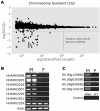A coffee berry borer (Hypothenemus hampei) genome assembly reveals a reduced chemosensory receptor gene repertoire and male-specific genome sequences
- PMID: 33649370
- PMCID: PMC7921381
- DOI: 10.1038/s41598-021-84068-1
A coffee berry borer (Hypothenemus hampei) genome assembly reveals a reduced chemosensory receptor gene repertoire and male-specific genome sequences
Abstract
Coffee berry borer-CBB (Hypothenemus hampei) is a globally important economic pest of coffee (Coffea spp.). Despite current insect control methods for managing CBB, development of future control strategies requires a better understanding of its biology and interaction with its host plant. Towards this objective, we performed de novo CBB genome and transcriptome sequencing, improved CBB genome assembly and predicted 18,765 protein-encoding genes. Using genome and transcriptome data, we annotated the genes associated with chemosensation and found a reduced gene repertoire composed by 67 odorant receptors (ORs), 62 gustatory receptors (GRs), 33 ionotropic receptors (IRs) and 29 odorant-binding proteins (OBPs). In silico transcript abundance analysis of these chemosensory genes revealed expression enrichment in CBB adults compared with larva. Detection of differentially expressed chemosensory genes between males and females is likely associated with differences in host-finding behavior between sexes. Additionally, we discovered male-specific genome content and identified candidate male-specific expressed genes on these scaffolds, suggesting that a Y-like chromosome may be involved in the CBB's functional haplodiploid mechanism of sex determination.
Conflict of interest statement
The authors declare no competing interests.
Figures







References
-
- Benavides, P., Gongora, C. & Bustillo, A. IPM Program to Control Coffee Berry Borer Hypothenemus hampei, with Emphasis on Highly Pathogenic Mixed Strains of Beauveria bassiana, to Overcome Insecticide Resistance in Colombia. In Insecticides—Advances in Integrated Pest Management (2012).
-
- Bergamin J. Contribuição para o conhecimento da biologia da broca do café Hypothenemus hampei (Ferrari, 1867) (Col. Ipidae) Arq. Inst. Biol. 1943;14:31–72.
-
- Kirkendall LR. Ecology and evolution of biased sex ratios in bark and ambrosia beetles. In: Wresh DL, Mercedes AE, editors. Evolution and Diversity of Sex Ratio in Insects and Mites. New York: Chapman & Hall; 1993. pp. 235–345.
Publication types
MeSH terms
Substances
LinkOut - more resources
Full Text Sources
Other Literature Sources
Miscellaneous

